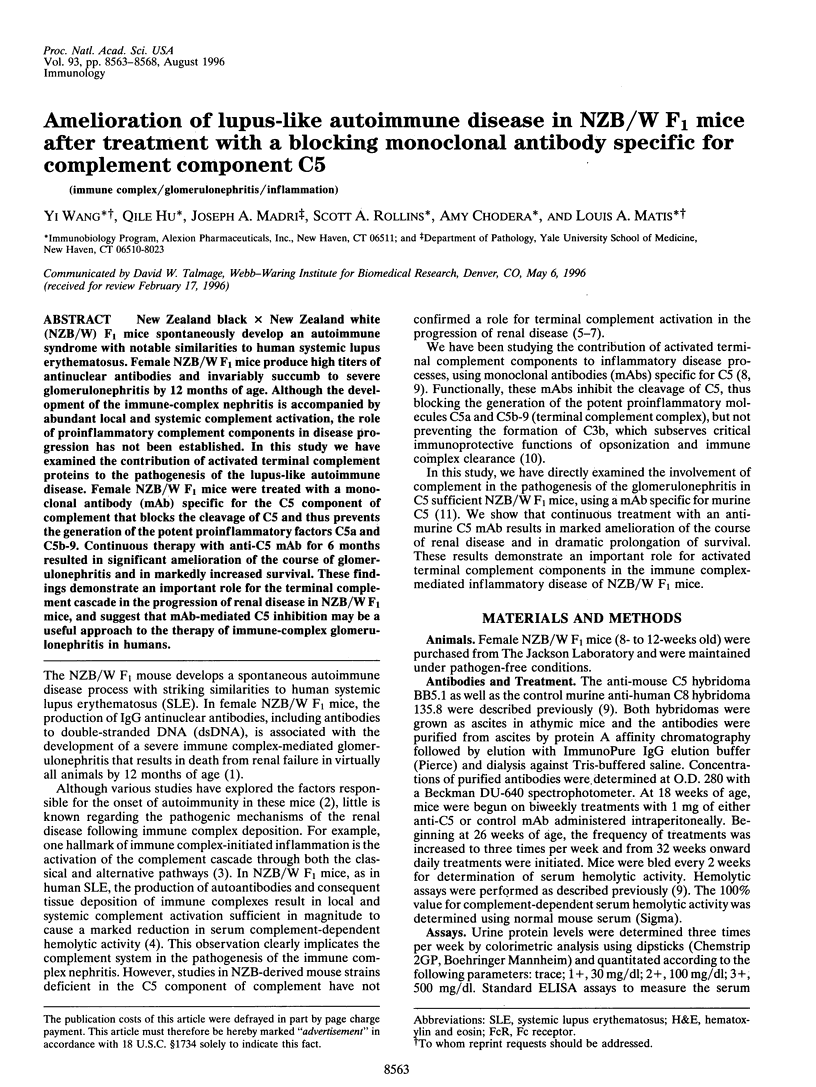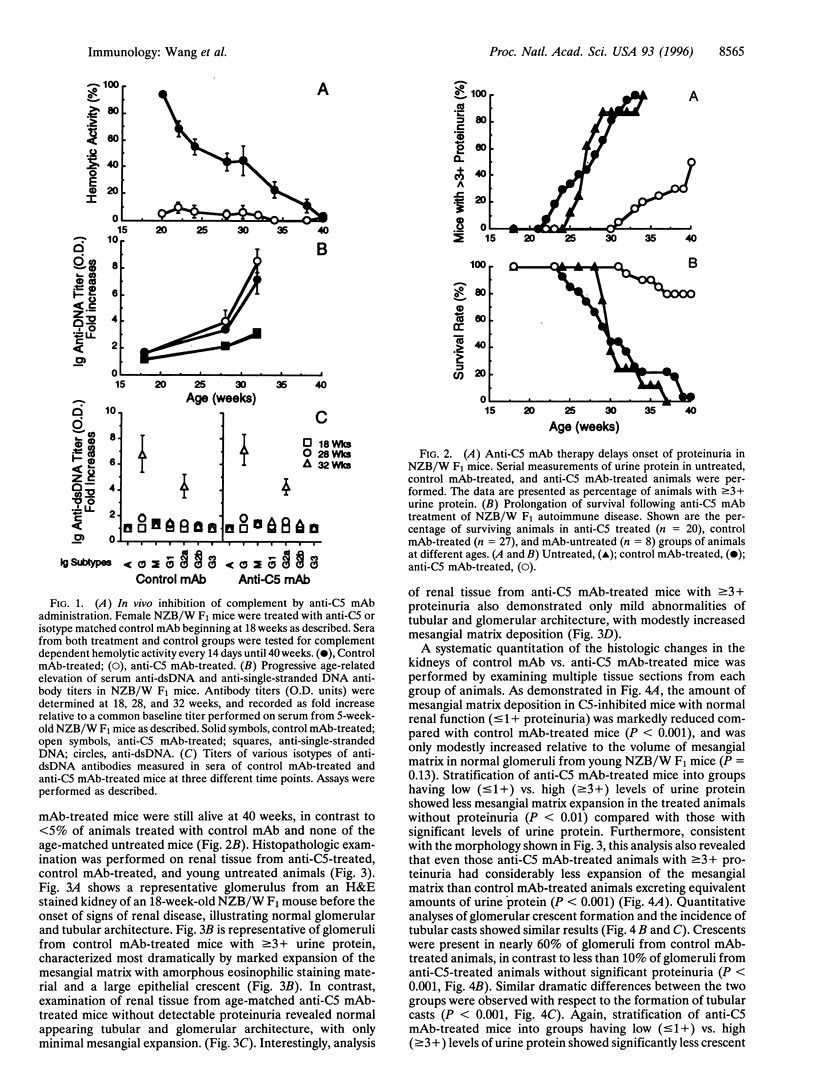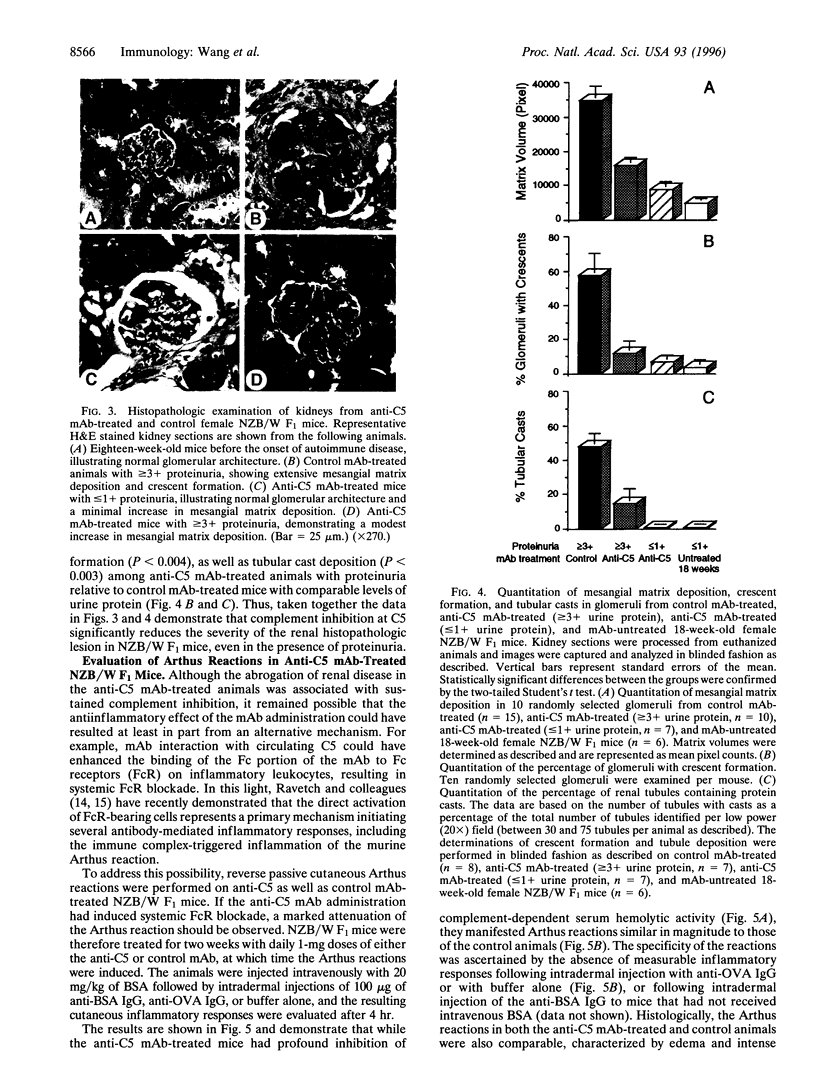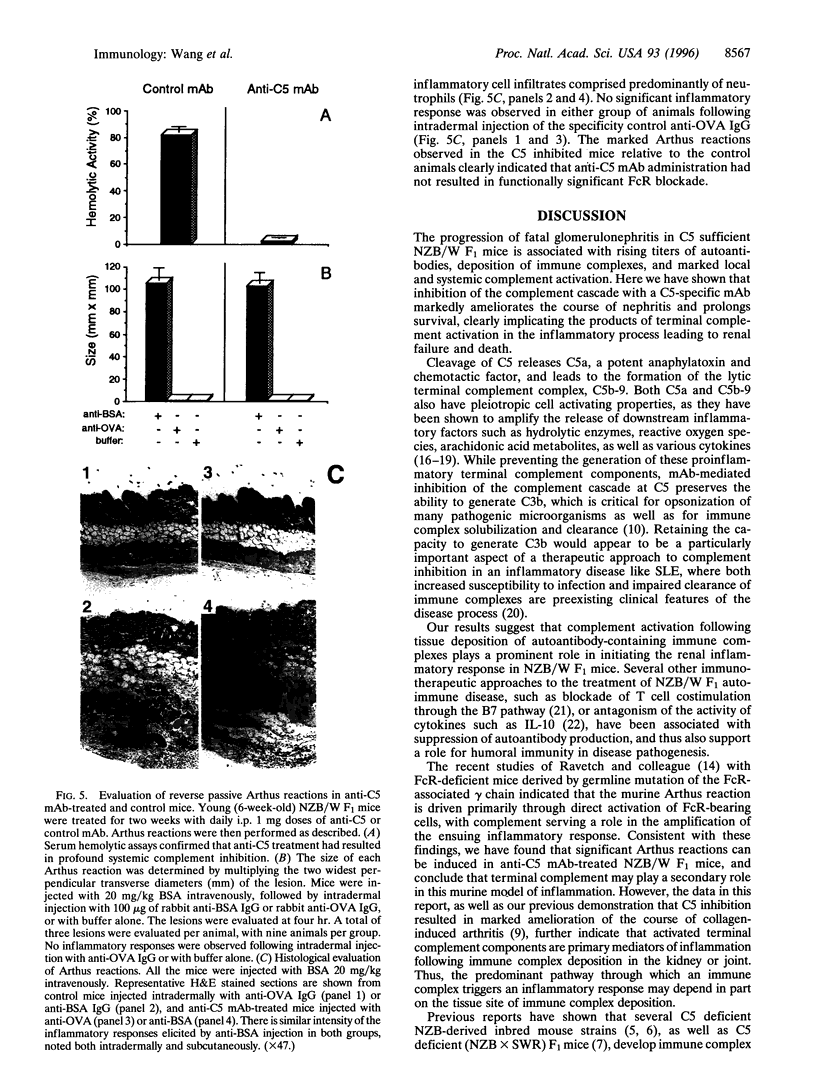Abstract
New Zealand black x New Zealand white (NZB/W) F1 mice spontaneously develop an autoimmune syndrome with notable similarities to human systemic lupus erythematosus. Female NZB/WF1 mice produce high titers of antinuclear antibodies and invariably succumb to severe glomerulonephritis by 12 months of age. Although the development of the immune-complex nephritis is accompanied by abundant local and systemic complement activation, the role of proinflammatory complement components in disease progression has not been established. In this study we have examined the contribution of activated terminal complement proteins to the pathogenesis of the lupus-like autoimmune disease. Female NZB/W F1 mice were treated with a monoclonal antibody (mAb) specific for the C5 component of complement that blocks the cleavage of C5 and thus prevents the generation of the potent proinflammatory factors C5a and C5b-9. Continuous therapy with anti-C5 mAb for 6 months resulted in significant amelioration of the course of glomerulonephritis and in markedly increased survival. These findings demonstrate an important role for the terminal complement cascade in the progression of renal disease in NZB/W F1 mice, and suggest that mAb-mediated C5 inhibition may be a useful approach to the therapy of immune-complex glomerulonephritis in humans.
Full text
PDF





Images in this article
Selected References
These references are in PubMed. This may not be the complete list of references from this article.
- Andrews B. S., Eisenberg R. A., Theofilopoulos A. N., Izui S., Wilson C. B., McConahey P. J., Murphy E. D., Roths J. B., Dixon F. J. Spontaneous murine lupus-like syndromes. Clinical and immunopathological manifestations in several strains. J Exp Med. 1978 Nov 1;148(5):1198–1215. doi: 10.1084/jem.148.5.1198. [DOI] [PMC free article] [PubMed] [Google Scholar]
- Behar S. M., Corbet S., Diamond B., Scharff M. D. The molecular origin of anti-DNA antibodies. Int Rev Immunol. 1989;5(1):23–42. doi: 10.3109/08830188909086988. [DOI] [PubMed] [Google Scholar]
- Clynes R., Ravetch J. V. Cytotoxic antibodies trigger inflammation through Fc receptors. Immunity. 1995 Jul;3(1):21–26. doi: 10.1016/1074-7613(95)90155-8. [DOI] [PubMed] [Google Scholar]
- Colten H. R. Immunology. Drawing a double-edged sword. Nature. 1994 Oct 6;371(6497):474–475. doi: 10.1038/371474a0. [DOI] [PubMed] [Google Scholar]
- Dalmasso A. P. Complement in the pathophysiology and diagnosis of human diseases. Crit Rev Clin Lab Sci. 1986;24(2):123–183. doi: 10.3109/10408368609110272. [DOI] [PubMed] [Google Scholar]
- Daniels R. H., Houston W. A., Petersen M. M., Williams J. D., Williams B. D., Morgan B. P. Stimulation of human rheumatoid synovial cells by non-lethal complement membrane attack. Immunology. 1990 Feb;69(2):237–242. [PMC free article] [PubMed] [Google Scholar]
- Datta S. K., Patel H., Berry D. Induction of a cationic shift in IgG anti-DNA autoantibodies. Role of T helper cells with classical and novel phenotypes in three murine models of lupus nephritis. J Exp Med. 1987 May 1;165(5):1252–1268. doi: 10.1084/jem.165.5.1252. [DOI] [PMC free article] [PubMed] [Google Scholar]
- Drake C. G., Babcock S. K., Palmer E., Kotzin B. L. Genetic analysis of the NZB contribution to lupus-like autoimmune disease in (NZB x NZW)F1 mice. Proc Natl Acad Sci U S A. 1994 Apr 26;91(9):4062–4066. doi: 10.1073/pnas.91.9.4062. [DOI] [PMC free article] [PubMed] [Google Scholar]
- Finck B. K., Linsley P. S., Wofsy D. Treatment of murine lupus with CTLA4Ig. Science. 1994 Aug 26;265(5176):1225–1227. doi: 10.1126/science.7520604. [DOI] [PubMed] [Google Scholar]
- Frei Y., Lambris J. D., Stockinger B. Generation of a monoclonal antibody to mouse C5 application in an ELISA assay for detection of anti-C5 antibodies. Mol Cell Probes. 1987 Jun;1(2):141–149. doi: 10.1016/0890-8508(87)90022-3. [DOI] [PubMed] [Google Scholar]
- Gerard C., Gerard N. P. C5A anaphylatoxin and its seven transmembrane-segment receptor. Annu Rev Immunol. 1994;12:775–808. doi: 10.1146/annurev.iy.12.040194.004015. [DOI] [PubMed] [Google Scholar]
- Ishida H., Muchamuel T., Sakaguchi S., Andrade S., Menon S., Howard M. Continuous administration of anti-interleukin 10 antibodies delays onset of autoimmunity in NZB/W F1 mice. J Exp Med. 1994 Jan 1;179(1):305–310. doi: 10.1084/jem.179.1.305. [DOI] [PMC free article] [PubMed] [Google Scholar]
- Jabs D. A., Burek C. L., Hu Q., Kuppers R. C., Lee B., Prendergast R. A. Anti-CD4 monoclonal antibody therapy suppresses autoimmune disease in MRL/Mp-lpr/lpr mice. Cell Immunol. 1992 May;141(2):496–507. doi: 10.1016/0008-8749(92)90166-m. [DOI] [PubMed] [Google Scholar]
- Konteatis Z. D., Siciliano S. J., Van Riper G., Molineaux C. J., Pandya S., Fischer P., Rosen H., Mumford R. A., Springer M. S. Development of C5a receptor antagonists. Differential loss of functional responses. J Immunol. 1994 Nov 1;153(9):4200–4205. [PubMed] [Google Scholar]
- Kühn R., Schwenk F., Aguet M., Rajewsky K. Inducible gene targeting in mice. Science. 1995 Sep 8;269(5229):1427–1429. doi: 10.1126/science.7660125. [DOI] [PubMed] [Google Scholar]
- Labow M. A., Norton C. R., Rumberger J. M., Lombard-Gillooly K. M., Shuster D. J., Hubbard J., Bertko R., Knaack P. A., Terry R. W., Harbison M. L. Characterization of E-selectin-deficient mice: demonstration of overlapping function of the endothelial selectins. Immunity. 1994 Nov;1(8):709–720. doi: 10.1016/1074-7613(94)90041-8. [DOI] [PubMed] [Google Scholar]
- Lanier B. G., McDuffie F. C., Holley K. E. Role of C5 in the nephritis of NZB-W mice. J Immunol. 1971 Mar;106(3):740–746. [PubMed] [Google Scholar]
- Matis L. A., Rollins S. A. Complement-specific antibodies: designing novel anti-inflammatories. Nat Med. 1995 Aug;1(8):839–842. doi: 10.1038/nm0895-839. [DOI] [PMC free article] [PubMed] [Google Scholar]
- Nicholson-Weller A., Halperin J. A. Membrane signaling by complement C5b-9, the membrane attack complex. Immunol Res. 1993;12(3):244–257. doi: 10.1007/BF02918256. [DOI] [PubMed] [Google Scholar]
- Rinder C. S., Rinder H. M., Smith B. R., Fitch J. C., Smith M. J., Tracey J. B., Matis L. A., Squinto S. P., Rollins S. A. Blockade of C5a and C5b-9 generation inhibits leukocyte and platelet activation during extracorporeal circulation. J Clin Invest. 1995 Sep;96(3):1564–1572. doi: 10.1172/JCI118195. [DOI] [PMC free article] [PubMed] [Google Scholar]
- Rudofsky U. H., Evans B. D., Balaban S. L., Mottironi V. D., Gabrielsen A. E. Differences in expression of lupus nephritis in New Zealand mixed H-2z homozygous inbred strains of mice derived from New Zealand black and New Zealand white mice. Origins and initial characterization. Lab Invest. 1993 Apr;68(4):419–426. [PubMed] [Google Scholar]
- Sylvestre D. L., Ravetch J. V. Fc receptors initiate the Arthus reaction: redefining the inflammatory cascade. Science. 1994 Aug 19;265(5175):1095–1098. doi: 10.1126/science.8066448. [DOI] [PubMed] [Google Scholar]
- Theofilopoulos A. N., Dixon F. J. Murine models of systemic lupus erythematosus. Adv Immunol. 1985;37:269–390. doi: 10.1016/s0065-2776(08)60342-9. [DOI] [PubMed] [Google Scholar]
- Thomas S. M., Soriano P., Imamoto A. Specific and redundant roles of Src and Fyn in organizing the cytoskeleton. Nature. 1995 Jul 20;376(6537):267–271. doi: 10.1038/376267a0. [DOI] [PubMed] [Google Scholar]
- Wang Y., Rollins S. A., Madri J. A., Matis L. A. Anti-C5 monoclonal antibody therapy prevents collagen-induced arthritis and ameliorates established disease. Proc Natl Acad Sci U S A. 1995 Sep 12;92(19):8955–8959. doi: 10.1073/pnas.92.19.8955. [DOI] [PMC free article] [PubMed] [Google Scholar]




